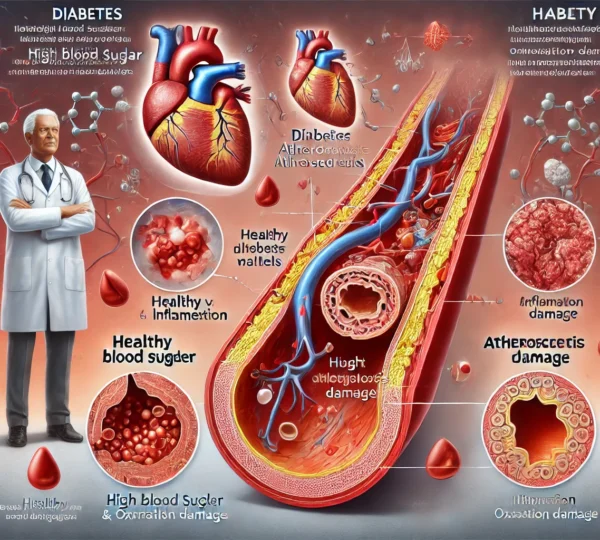Atherosclerosis and Diabetes: Understanding the Connection
Understanding the Link Between Diabetes and Atherosclerosis
Introduction
Atherosclerosis and diabetes are closely linked. Understanding this connection is crucial for effectively managing both conditions. Let’s delve into how diabetes impacts atherosclerosis and what you can do to protect your heart health.
1. How Diabetes Affects Atherosclerosis
Diabetes can damage blood vessels. This damage makes them more prone to plaque buildup, leading to atherosclerosis. High blood sugar levels increase inflammation and oxidative stress. These factors further contribute to the development of atherosclerosis.
2. Increased Risk of Complications
People with diabetes face a higher risk of atherosclerosis and its complications. These complications include coronary artery disease, stroke, and peripheral artery disease. Atherosclerosis progresses more rapidly in individuals with diabetes. As a result, they may experience earlier onset and more severe symptoms.
3. Managing Diabetes and Atherosclerosis
Controlling blood sugar levels is essential. This management reduces the risk of atherosclerosis. Follow your healthcare provider’s recommendations for monitoring blood sugar, taking medications, and making lifestyle changes.
Heart-Healthy Lifestyle
Adopting a heart-healthy lifestyle can help prevent and manage both conditions. Key components include:
- Balanced Diet: Focus on whole foods, such as fruits, vegetables, whole grains, and lean proteins.
- Regular Exercise: Aim for at least 150 minutes of moderate exercise each week.
- Healthy Weight: Maintain a healthy weight to improve overall health.
- Quit Smoking: Smoking exacerbates heart disease risk and atherosclerosis.
- Stress Management: Incorporate stress-reducing activities like yoga or meditation.
4. Regular Monitoring and Screening
People with diabetes should undergo regular monitoring for atherosclerosis and related complications. This monitoring may include tests for:
- Cholesterol levels
- Blood pressure
- Heart function
Work closely with your healthcare provider to develop a personalized treatment plan. This plan should address both diabetes and atherosclerosis risk factors.
5. Medications and Interventions
In some cases, medications may be necessary to manage both diabetes and atherosclerosis. Common prescriptions include:
- Statins: These help lower cholesterol levels.
- Blood Pressure Medications: These control blood pressure and reduce heart strain.
In severe cases of atherosclerosis, interventional procedures may be needed. These can include angioplasty or bypass surgery to improve blood flow.
Conclusion
Understanding the connection between diabetes and atherosclerosis is vital. By controlling blood sugar levels and adopting a healthy lifestyle, you can manage both conditions effectively. Regular monitoring and working closely with your healthcare provider will help protect your heart health and overall well-being.
To seek medical advice, always consult a Doctor. Here are our recommended experts.
Click here
To read more on Heart Disease . Click Here



